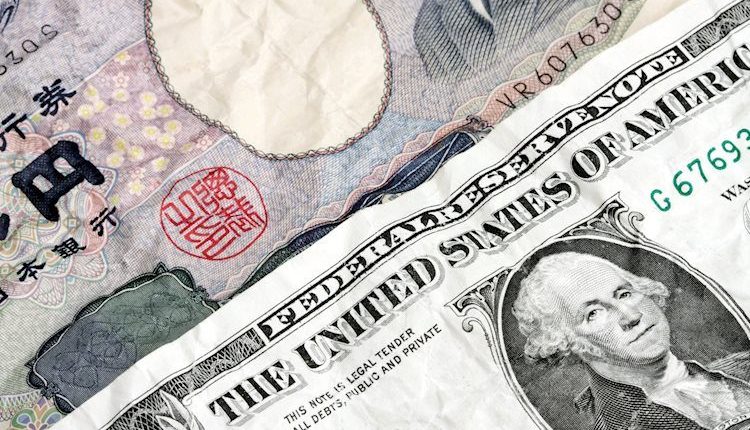- The Japanese Yen edges higher against the US Dollar for the second straight day on Friday.
- A softer risk tone, trade war fears, and geopolitical risks further benefit the safe-haven JPY.
- The USD/JPY bears seem reluctant to place aggressive bets ahead of the key US NFP report.
The Japanese Yen (JPY) attracts some follow-through buying during the Asian session on Friday and builds on the previous day’s gains against its American counterpart in the wake of the Bank of Japan’s (BoJ) more hawkish stance. In fact, the BoJ remains on track for more interest rate hikes, while other major central banks, including the US Federal Reserve (Fed), are seen lowering borrowing costs further.
Apart from this, a slight deterioration in the global risk sentiment, geopolitical tensions and trade war fears continue to underpin the safe-haven JPY. Moreover, the recent decline in the US Treasury bond yield keeps the US Dollar (USD) depressed near a multi-week low and further benefits the lower-yielding JPY. Traders, however, might opt to wait on the sidelines ahead of the US Nonfarm Payrolls (NFP) report.
Japanese Yen is underpinned by hawkish BoJ bets and safe-haven demand
- The Japanese Yen struggles to gain any meaningful traction as traders look to find out whether the Bank of Japan will deliver another interest rate hike at its upcoming monetary policy meeting later this month.
- BoJ Governor Kazuo Ueda said last week that rate hikes are nearing in the sense that economic data are on track. BoJ’s Toyoaki Nakamura said on Thursday that the central bank must move cautiously in raising rates.
- Russia has pounded Ukraine with long-range weapons and sustained ground assaults in the country’s east during the past week and has shown little sign of fatigue in the conflict, which has been raging for nearly two years.
- Adding to this, concerns that US President Donald Trump’s trade tariff could trigger the second wave of global trade wars temper investors’ appetite for riskier assets and offer some support to the safe-haven JPY.
- According to the CME Group’s FedWatch Tool, the markets are pricing in a 70% chance that the Federal Reserve will lower borrowing costs by 25 basis points at the December meeting and a 30% probability of a pause.
- Rate cut bets held broadly steady after the US Department of Labor (DoL) reported on Thursday that Initial Jobless Claims rose to 224K for the week ended November 29, from the previous week’s upwardly revised 215K print.
- The yield on the benchmark 10-year US government bond languishes near its lowest level since October 22 and further benefits the lower-yielding JPY, though a modest US Dollar uptick lends support to the USD/JPY pair.
- The market attention remains glued to the US Nonfarm Payrolls (NFP) report, which will guide Fed policymakers on their next policy decision. This, in turn, will influence the USD and provide a fresh impetus to the currency pair.
USD/JPY could weaken further once the 149.65 immediate support is broken
From a technical perspective, the overnight swing low, around the 148.65 region, now seems to protect the immediate downside ahead of the 149.00 mark and the 100-day SMA, currently around the 148.80 region. The latter should act as a key pivotal point, which if broken decisively will be seen as a fresh trigger for bearish traders. Given that oscillators on the daily chart are holding in negative territory, the USD/JPY pair might then slide to the 148.10-148.00 region en route to the 147.35-147.30 zone and the 147.00 round figure.
On the flip side, attempted recovery might now confront some resistance near the 150.55 region. This is followed by the 150.70 hurdle, the 151.00 round figure and the weekly high, around the 151.20-151.25 zone touched on Wednesday. A sustained move beyond the latter could lift the USD/JPY pair to the 152.00 mark, or the very important 200-day SMA. Some follow-through buying will suggest that the recent corrective decline from a multi-month high touched in November has run its course and shift the bias in favor of bullish traders.
Bank of Japan FAQs
The Bank of Japan (BoJ) is the Japanese central bank, which sets monetary policy in the country. Its mandate is to issue banknotes and carry out currency and monetary control to ensure price stability, which means an inflation target of around 2%.
The Bank of Japan embarked in an ultra-loose monetary policy in 2013 in order to stimulate the economy and fuel inflation amid a low-inflationary environment. The bank’s policy is based on Quantitative and Qualitative Easing (QQE), or printing notes to buy assets such as government or corporate bonds to provide liquidity. In 2016, the bank doubled down on its strategy and further loosened policy by first introducing negative interest rates and then directly controlling the yield of its 10-year government bonds. In March 2024, the BoJ lifted interest rates, effectively retreating from the ultra-loose monetary policy stance.
The Bank’s massive stimulus caused the Yen to depreciate against its main currency peers. This process exacerbated in 2022 and 2023 due to an increasing policy divergence between the Bank of Japan and other main central banks, which opted to increase interest rates sharply to fight decades-high levels of inflation. The BoJ’s policy led to a widening differential with other currencies, dragging down the value of the Yen. This trend partly reversed in 2024, when the BoJ decided to abandon its ultra-loose policy stance.
A weaker Yen and the spike in global energy prices led to an increase in Japanese inflation, which exceeded the BoJ’s 2% target. The prospect of rising salaries in the country – a key element fuelling inflation – also contributed to the move.
Read the full article here

